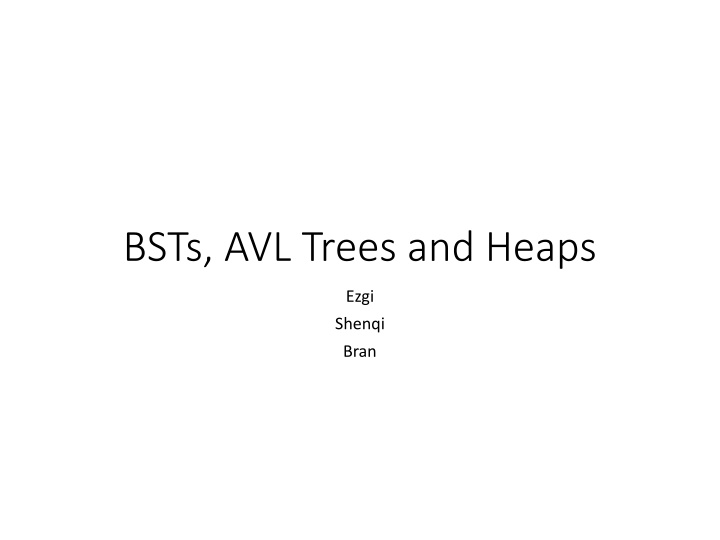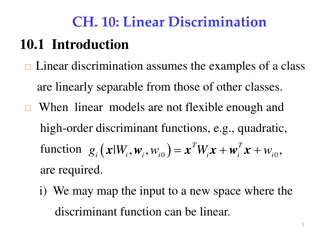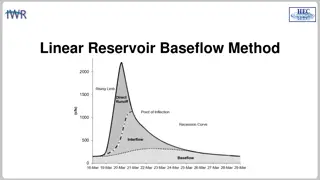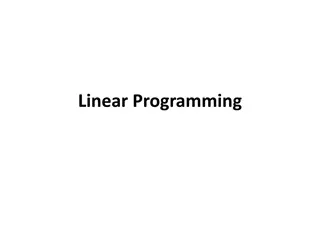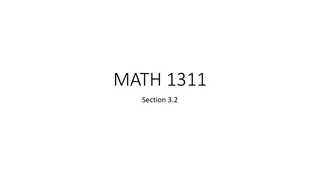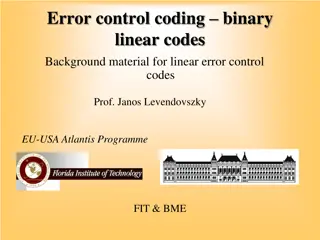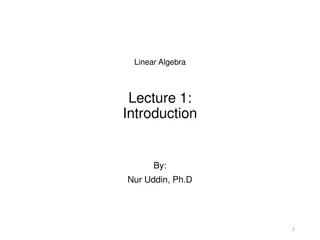Linear Independence and Wronskians in ECE: Fall 2023 Notes
This content discusses linear independence of functions, particularly on the real axis, and explores the concept through examples. It highlights how functions can be linearly dependent or independent based on specific intervals, emphasizing the significance of this distinction in mathematical contexts. The discussion delves into scenarios where functions can be expressed as combinations of others, showcasing the interplay between linear independence and dependence.
Download Presentation

Please find below an Image/Link to download the presentation.
The content on the website is provided AS IS for your information and personal use only. It may not be sold, licensed, or shared on other websites without obtaining consent from the author.If you encounter any issues during the download, it is possible that the publisher has removed the file from their server.
You are allowed to download the files provided on this website for personal or commercial use, subject to the condition that they are used lawfully. All files are the property of their respective owners.
The content on the website is provided AS IS for your information and personal use only. It may not be sold, licensed, or shared on other websites without obtaining consent from the author.
E N D
Presentation Transcript
BSTs, AVL Trees and Heaps Ezgi Shenqi Bran
What to know about Trees? Height of a tree Length of the longest path from root to a leaf Height of an empty tree is -1. Height = 1 Height = 2 Height = 0 A A A B B Depth of a node Length of the path from root to the node Depth of node A is 0 Depth of node B is 1 Depth of node C is 2 Recursion Each of the children is the root of a sub-tree. (including null children) C D
Binary Trees Each node at most 2 children
Traversals and Recursion void preOrderTr(Node t){ if(t != null) { process(t.element); preOrderTr(t.left); preOrderTr(t.right); } } void inOrderTr(Node t){ if(t != null) { inOrderTr(t.left); process(t.element); inOrderTr(t.right); } } void postOrderTr(Node t){ if(t != null) { postOrderTr(t.left); postOrderTr(t.right); process(t.element); } }
Binary Search Trees Each node has a key and a value For any node (recursion!) All keys in left subtree are smaller than the node s key All keys in right subtree are larger than the node s key Operations: find insert delete buildTree
find(root, key) Recursive? Base cases? Recursive calls? find (tree, key): data if tree is empty : return null if key is equal to root s key: return root s data if key is smaller than root s key: find in the left subtree if key is larger than root s key: find in the right subtree
find(root, key) Data find(Node root, Key key){ if(root == null) return null; if (key == root.key) return root.data; if (key < root.key) return find(root.left, key); if (key > root.key) return find(root.right, key); return root.data; }
insert Let s insert 15, 21, 16, 20, 17, 18, 19 14 Worst case: O(n) Best case: O(1) Average case: O(logn) 15 21 If only there was a structure that is always bounded by the smallest possible height 16 20 17 18 19
delete find the node remove the node fix the tree removed node has no children removed node has one child removed node has two children nothing to fix replace the removed node with the child replace the removed node with something something > everything in the left subtree and something < everything in the right subtree
Deletion The Two Child Case 12 delete(5) 5 20 2 9 30 Complexity based on find: Worst case: O(n) Best case: O(1) Average case: O(logn) 4 7 10 largest value on its left smallest value on its right something > everything in the left subtree and something < everything in the right subtree What can we replace 5 with? Spring 2016 10 CSE373: Data Structures & Algorithms
AVL Tree 1. BST 2. How to recognize an AVL Tree? 3. How to keep the balance of AVL Tree? Another example: [ Spring 2010 Midterm ] Insert 2, 8, 3, 9, 5, 4, 10 to an initially empty AVL Tree.
Heap Example: Insert Heap Example: Insert 4 Is this a valid heap? Is it a valid binary search tree? 4 5 24 6 8 7 To insert: 2 4 5 4 24 6 8 7
Heap Example: Insert Heap Example: Insert 4 4 5 24 6 8 7 2 4 5 4 24 6 8 7 2
Heap Example: Insert Heap Example: Insert 4 4 5 2 6 8 7 24 4 5 4 2 6 8 7 24
Heap Example: Insert Heap Example: Insert 4 4 2 5 6 8 7 24 4 2 4 5 6 8 7 24
Heap Example: Insert Heap Example: Insert 2 4 4 5 6 8 7 24 2 4 4 5 6 8 7 24
Heap Example: Delete Heap Example: Delete 2 What is deleted? 4 4 5 6 8 7 24 2 4 4 5 6 8 7 24
Heap Example: Delete Heap Example: Delete ? 24 2 What is deleted? 2 4 4 5 6 8 7 ? 4 4 5 6 8 7
Heap Example: Delete Heap Example: Delete 24 4 What is deleted? ? 2 4 4 5 6 8 7 4 ? 4 5 6 8 7
Heap Example: Delete Heap Example: Delete 4 What is deleted? 24 2 4 5 ? 5 6 8 7 4 5 4 ? 6 8 7
Heap Example: Delete Heap Example: Delete 4 What is deleted? 2 4 5 24 6 8 7 4 5 4 24 6 8 7
Heap Example: Delete Heap Example: Delete 4 What is deleted? 2 4 5 24 6 8 7 4 5 4 24 6 8 7
